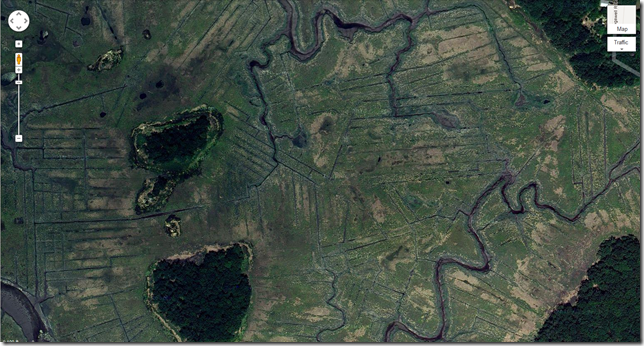Who cuts the symmetrical lines in the marshes? It’s obviously done to provide salt water with nutrients and keep the marsh healthy (that didn’t sound very scientific did it?)
Can someone clue us in as to what they are about and who cuts them in or cut them in and how are they maintained? This is just a random screen shot of a google map near Farnhams in Essex MA
There are several links to websites which explain how they came to be and yes it was a WPA depression project designed for mosquito control.
Good articles about it can be read here and here
Penelope Crane also forwarded this–


Joey,
I was told one time that the cuts in the marsh were done as part of a WPA project in the 30’s in an attempt to ‘drain’ the marshes and help with the mosquito/greenhead problem. I think this was done in a time when the importance of the marsh ecosystem wasn’t fully understood and I don’t think it’s maintained. I’m far from an expert so I’d love to find out if this is true.
In the past, these marshlands were valuable to local farmers – they used to mow the marsh grass to create salt-hay for their animals.
LikeLike
ALIENS! From other Planets make those cuts. Look towards boston at night from Niles Beach or the Boulevard and you can see the lights of the UFOS floating above the ocean. And make sure you’ve had a Ryan & woods mixed drink before viewing 🙂
LikeLike
Justin’s got it right, at least in part. WPA projects cut (or re-cut) a lot of marsh drainage in Essex County and elsewhere primarily for mosquito control. Also, from colonial days through the 1920’s local farmers depended on marsh hay and originally cut and kept open many marshes off Ipswich Bay from Cape ann into Maine and also on Cape Cod. Farms were a big part of the economy through the 180o’s and early 1900’s. Many old deeds in those areas included, not only, the homestead but deeds to marshland.
I think Paul’s got it part right too. Always were mysterious nightly goings on in places like Dogtown, Joppa. Dunfuggin and elsewhere around Cape Ann.
LikeLike
its is a wpa works project!
LikeLike
Along the coastal regions of South Carolina and Georgia the plantations converted salt marshes into farmland a levee or dyke would be built at the mouth of a creek stopping the tide and the marsh would become a freshwater enviroment.
LikeLike
“Mosquito control” needs clarification; the young fry would eat the mosquito larvae in the shallow channels. The next question is did they work and do they still work as designed?
LikeLike
It is even in the marshes in East gloucester off Bass Ave & Hartz St
LikeLike
When I was At Eastern Ave. School in the 5th.and 6th. grades their we a few people who use to collect the salt marsh hay; but soon after never saw anyone doing it any more. Then in the name of progress houses,roadways and marinas where built chocking off the marsh from the multispecies of fish and shrimp from their natural course.There was a time when tons of baby fish were in these marshs,harbor and coves ,then they were no more. Fish started laying eggs in deeper waters with less protection plus natural cycles in water temp. Then some silly goose said it’s overfishing ; and we can chock the fisherman’s neck but not progress.So here we are the 21 st. century but are we smarter?
LikeLike
The marshes from the 128 extension to Good Harbor (just about) were always loaded with minnows and eels would try to get at them, they would be in the minnow traps, and in the evenings sometimes you could see schools of fish going under the Good Harbor foot-bridge in search of eels and minnows so that was, in the 60s and 70s still an ecosystem still contributing to the oceans fish. I don’t believe these fish were herring or river herring looking to return to their spawning grounds as they would come and go with the tides. I always got the impression that they were sand sharks, since each female only has one pup at a time generally, there must still have been a lot out there. Some of the European factory ships liked to leave them alone, they were hard on the nets, they would only target them when there was nothing else around so I h0pe that helped save their hides. The marsh grasses have been taken over by invasive species of plants around Hartz St. and that’s never really a good sign though.
LikeLike
How were these ‘cuts’ ever made? Do they have a name? When dug out where did they put what they dug out? they are deep…they don’t seem to fill in….. how come?
LikeLike